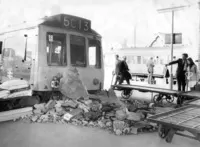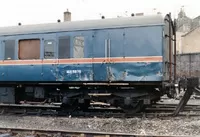Class 127 Derby 4-car DMUs
Accidents
These are some of the accidents that are known to involve Class 127s.
10/12/63 - Between Glendon Junction and Kettering, LMR
Derailment involving Class 127
Info from Bill Read
Derailment of Class 127 + unidentified twin unit. M51609 – no other cars identified. Minor injuries. While travelling at 60mph, a complete engine and torque converter weighing 2.5 tons fell from M51609 causing extensive damage to the vehicle and derailing all cars. A small fire broke out. The conclusion was that the unit was released into service, after overhaul at Derby Works, with loose torque-converter securing bolts. This caused progressive overloading of other bolts, brackets and cardan shaft until final failure.
10/10/64 - Between Milbrook and Wilshamstead, LMR
Fire involving Class 127
Class 127 on fire after breaking cardan shaft. M51591 (trailing car). 1 passenger killed, 4 injured. The rotating ends of the broken cardan shaft punctured the fuel tank. The resulting fire caused some damage to the trailing cab but did not penetrate the saloon. Examination of other units found that some 40 cardan shafts were bent, probably as a result of careless handling when torque converters were changed, and this was assumed to have caused the failure.
18/08/65 - Sandridge, near St.Albans, LMR
Fire involving Class 127
Info from Peter Mullen
A 4-car DMU was travelling from St. Pancras to Luton when a fire broke out under the rear power car (M51594) about 1 mile north of St. Albans. More Details.
early 1966 - Unknown
Collision involving Class 127
A Class 127 DMBS was photographed in Cricklewood with damage to the cab, cause unknown.
09/02/66 - Napsbury, LMR
Fire involving Class 127
Info from Bill Read
During investigation of excessive wear in the torque convertors of the Class 127 units, M51622 was fitted with test equipment which caused the cardan shaft to break up, rupture the fuel tank and catch fire. More Details.
23/12/66 - Kentish Town
Collision involving Class 127
51611 was damaged in an incident at Kentish Town.
12/06/68 - Sandridge (near St.Albans), LMR
Fire involving Class 112 / Class 127
Info from Vehicle numbers: Railway Observer p404 November 1968
A train consisting of a 4-car Class 127 (leading) and two 2-car Class 112s (believed to include 51690 and 51726) suffered severe vibration under the seventh coach. Almost at once there seemed to be a minor explosion and seconds later the vehicle became full of choking smoke and fumes, while smoke & fumes emanated from the underside of both rear coaches. As the train slowed down passengers began to jump, killing two and injuring ten others. More Details.
11 June 1974 - St Albans City, LMR
Collision involving Class 127
A Class 127 hit the buffers in St Albans City station.
11/01/75 - Location unknown
Fire involving Class 127
M51629 suffered fire damage while leading an eight-car formation on the 17:16 Luton to St.Pancras football special.
25/06/76 - Luton, LMR
Collision involving Class 127 / Class 127
Info from Robert Frise and Bill Read
An empty stock Class 127 unit was struck on a crossover by another Class 127 unit which had passed two red signals. The latter was deflected towards the Down fast line where it was struck a glancing blow by an express passenger train hauled by a Class 45 locomotive. Minor injuries. More Details.
8/11/77 - Napsbury, LMR
Collision involving Class 127 / Class 127
Info from Peter Mullen
A set (5C26) travelling from Bedford to St. Pancras collided at about 40mph with the rear of a St. Albans to St. Pancras empty coaching stock train (2C65) which was standing at a signal. The collision resulted in the derailment of the two leading coaches of the passenger train as well as the rear coach of the empty stock train. The driver, guard and two passengers in the passenger train were injured and taken to hospital. Both trains were 4-car Class 127 DMUs comprising of vehicles 51626, 59609, 59643 and 51641 (5C26) and 51617, 59617, 59631 and 51601 (2C65) respectively. The accident was a result of the signalman forgetting about the stationary train at the St. Albans Up Slow Starting Signal and instructing the driver of the passenger train to pass the St. Albans Inner Home signal at Danger into an already occupied section.
1st April 1983 - Bedford Carriage Sidings
Fire involving Class 127
M51595 and M51614 were gutted by fire at Bedford Carriage Sidings, the cause thought to be a smouldering cigarette end. Both were withdrawn.
28/05/83 - Luton, LMR
Collision involving Class 127 / Class 47
Info from Eddie Knorn / Michael Boot
A stationary Class 127 was hit by 47 535 in Luton station, despite the severity of the damage there were no serious casualties. The rear half of DMBS 51620 was destroyed, as was one end of TSL 59605 - which had just been outshopped from Swindon after a C3 overhaul in January and painted into blue and grey for transfer to Tyseley. Both were withdrawn. The other two vehicles in the set were likely to be 59634 (also having a C3 at the same time as 59605) and 51624.
06/01/87 - Camden
Collision involving Class 127 / EMU
Info from p105 March 1987 Railway Observer, Michael Boot
Class 127 parcel DPU was crossing from the down fast to down slow at Camden when it was in a collision at 21:40 with a Class 313 EMU on the 21:37 Euston-Watford service. All DPU wheels were derailed with it blocking the down mail lines and up slow.
Fire Repairs
Ron Stringer worked at Derby C&W from 1963 to 1980, and notes[1]: "I worked on a 127 that had been fire damaged and the underframe had sagged under the weight of the engines. The centre portion of the body was fire damaged. The vehicle was lifted in U shop and the damaged centre portion was cut away and rebuilt. The vehicle was completely repaired and I believe returned to service. On the outside of the underframe there were lozenge shaped strengthening plates visible in the area around the drive axles where the joint had been made."
References
- ⋏ Email from Ron Stringer to Stuart Mackay 3 May 2021
Summary
Background
Description
Power Train
Interiors
Works Photos
Diagrams & Design Codes
Driving Instructions
Numbering
Liveries
Operations
Accidents
Parcel Use
Images
Details about preserved Class 127s can be found here.
Also relavant is the article "Working the DMUs" by Cricklewood Driver Arno Brooks.









